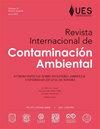Acid mine drainage treatment using chicken eggshell waste
IF 0.4
4区 环境科学与生态学
Q4 ENVIRONMENTAL SCIENCES
引用次数: 1
Abstract
Acid mine drainage (AMD) is a source of soil and water resources pollution. Calcite is a mineral constituted of calcium carbonate (CaCO3). The AMD interaction with calcite drives their natural neutralization. Calcite is the main component of the chicken eggshell (ES). This work aimed to evaluate the use of ES waste as a material to treat raw AMD. Five treatments (T1, T2, T3, T4, and T5) were carried out with concentrations of 1, 2, 3, 4, and 5 ES g/L AMD, respectively. Each treatment was performed for 3 h at room temperature without agitation. The response variables analyzed were pH, redox potential (Eh), electrical conductivity (σ), chlorides (Cl–), alkalinity, sulfates (SO42–), nitrates (NO3–, and potentially toxic heavy metals and metalloids (PTHMM). Also, the removal efficiencies of SO42–, NO3–, and PTHMM were analyzed. Additionally, the chemical and mineralogical composition of ES and precipitates were determined. The initial pH for AMD was 2.50 and it reached a final value of 5.50, 5.60, 5.80, 5.93, and 6.12 in T1, T2, T3, T4 and, T5, respectively. Moreover, the different treatments granted alkalinity to the treated effluents, reaching a maximum value of 124 CaCO3 mg/L in T5. Finally, Al and Fe were completely removed from AMD, whereas Cu reached > 95 % removal, especially in T3, T4, and T5. Ba, Cr, and Pb showed an average removal of ~65 %. The ES concentration that showed the best results of neutralization and PTHMM removal efficiency was 5 ES g/L. The results showed that ES is a biocompatible waste material with an added value because it can be used as a sustainable material to treat raw AMD.利用鸡蛋壳渣处理酸性矿山废水
酸性矿井水是土壤和水资源污染的主要来源之一。方解石是一种由碳酸钙(CaCO3)组成的矿物。AMD与方解石的相互作用驱动其自然中和。方解石是鸡蛋壳(ES)的主要成分。本研究旨在评价ES废弃物作为原料处理AMD的可行性。5个处理(T1、T2、T3、T4和T5), AMD浓度分别为1、2、3、4和5 ES g/L。每次处理在室温下不搅拌3小时。分析的响应变量为pH、氧化还原电位(Eh)、电导率(σ)、氯化物(Cl -)、碱度、硫酸盐(SO42 -)、硝酸盐(NO3 -)和潜在有毒重金属和类金属(PTHMM)。并对SO42 -、NO3 -和PTHMM的去除率进行了分析。此外,测定了ES和沉淀物的化学和矿物组成。AMD的初始pH为2.50,T1、T2、T3、T4和T5的最终pH分别为5.50、5.60、5.80、5.93和6.12。此外,不同的处理使处理后的废水具有碱性,在T5中达到124 CaCO3 mg/L的最大值。最后,Al和Fe在AMD中被完全去除,而Cu的去除率达到95%,特别是在T3、T4和T5中。Ba、Cr、Pb的平均去除率为~ 65%。中和效果最好的ES浓度为5 ES g/L,对PTHMM去除率最高。结果表明,ES是一种具有生物相容性的废弃物,可作为一种可持续处理原料AMD的材料,具有一定的附加价值。
本文章由计算机程序翻译,如有差异,请以英文原文为准。
求助全文
约1分钟内获得全文
求助全文
来源期刊

Revista Internacional De Contaminacion Ambiental
ENVIRONMENTAL SCIENCES-
CiteScore
0.90
自引率
16.70%
发文量
59
期刊介绍:
En esta revista se aceptan para su publicación trabajos originales y de revisión sobre aspectos físicos y químicos de la contaminación, investigaciones sobre la distribución y los efectos biológicos y ecológicos de los contaminantes; así como sobre tecnología e implementación de nuevas técnicas para su medida y control; también son aceptados estudios sociológicos, económicos y legales acerca del tema. Se publicarán los escritos que mediante arbitraje de especialistas y a juicio del Consejo Editorial tengan el nivel y la calidad adecuados para ello y su contenido será responsabilidad única de los autores. La Revista Internacional de Contaminación Ambiental es de periodicidad trimestral y se publica los días 1 de febrero, mayo, agosto y noviembre.
 求助内容:
求助内容: 应助结果提醒方式:
应助结果提醒方式:


